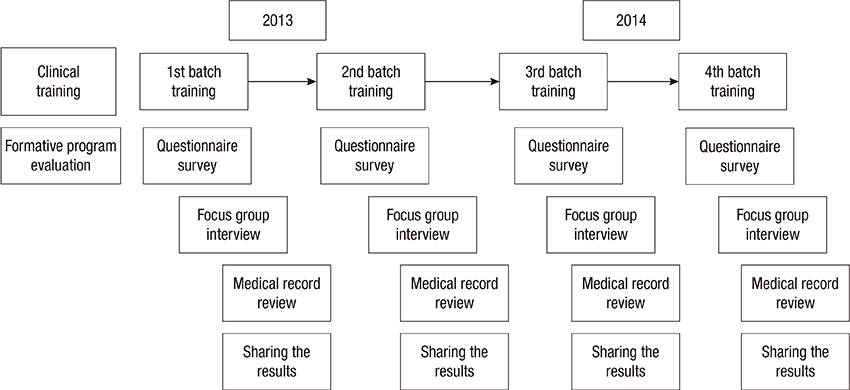J Korean Med Sci.
2015 Dec;30(12):1743-1747. 10.3346/jkms.2015.30.12.1743.
The Effect of Formative Program Evaluation on Continuous Program Improvement: A Case Study of a Clinical Training Program in Lao PDR
- Affiliations
-
- 1Department of Medical Education, Seoul National University College of Medicine, Seoul, Korea. hismed1@snu.ac.kr
- 2Education Development Center, University of Health Sciences, Vientiane, Lao PDR.
- KMID: 2359957
- DOI: http://doi.org/10.3346/jkms.2015.30.12.1743
Abstract
- This study aimed to evaluate the effect of the formative program evaluation on the continuous improvement of a clinical training program for Lao health professionals. The training program was conducted 4 times consecutively for total 48 health professionals, and the formative program evaluation was carried out during the whole process. To evaluate the satisfaction and the transfer of the trainees, the questionnaire survey, the focus group interview, and the trainees' medical records were used. After the end of each batch of the program, the evaluation data were analyzed, and its results were shared with the training management committee and the trainers, who, based on the results, reached a consensus on how to improve the program. The evaluation results and the comparison of them among the four batches of the program showed that there was a continuous increase of the satisfaction and the transfer of the trainees, especially in the early period of the program. The formative program evaluation which was conducted during the whole process of the clinical training program had a positive effect on the improvement of the program, especially in the early phase, by increasing the satisfaction and transfer of the trainees.
Figure
Cited by 1 articles
-
Evaluation of a continuing professional development training program for physicians and physician assistants in hospitals in Laos based on the Kirkpatrick model
Hyun Bae Yoon, Jwa-Seop Shin, Ketsomsouk Bouphavanh, Yu Min Kang
J Educ Eval Health Prof. 2016;13:21. doi: 10.3352/jeehp.2016.13.21.
Reference
-
1. Stevens F, Lawrenz F, Sharp L. User-friendly handbook for project evaluation: science, mathematics, engineering, and technology education. Arlington, VA: National Science Foundation;1995.2. Scriven M. Evaluation thesaurus. 4th ed. Newbury Park, CA: Sage;1991.3. Guskey TR. Evaluating professional development. Thousand Oaks, CA: Corwin Press;2000.4. Sriven M. The methodology of evaluation. Curriculum evaluation. Chicago: Rand McNally;1967. (Stake RE, ed. American Educational Research Association Monograph Series on Evaluation; No 1).5. Brown JL, Kiernan NE. Assessing the subsequent effect of a formative evaluation on a program. Eval Program Plann. 2001; 24:129–143.6. World Health Organization. Ministry of Health of Lao PDR. Health service delivery profile. Vientiane: WHO; Ministry of Health, Lao PDR;2012.7. World Health Organization. Human resources for health country profiles: Lao People's Democratic Republic. Geneva: World Health Organization;2013.8. College of Medicine, Seoul National University. Seoul National University Hospital. Final report of the continuing professional development training project to strengthen the capacity of provincial and district hospitals in Lao PDR (2012 - 2014). Seoul: Seoul National University;2015.9. Kirkpatrick DL. Techniques for evaluating training programs. J Am Soc Train Dir. 1959; 13:21–26.10. Kirkpatrick DL. Evaluating training programs: the four levels. 2nd ed. San Francisco: Berrett-Koehler Publishers;1998.11. Omar M, Gerein N, Tarin E, Butcher C, Pearson S, Heidari G. Training evaluation: a case study of training Iranian health managers. Hum Resour Health. 2009; 7:20.12. Yardley S, Dornan T. Kirkpatrick's levels and education 'evidence'. Med Educ. 2012; 46:97–106.13. Woloschuk W, Coderre S, Wright B, McLaughlin K. What factors affect students' overall ratings of a course? Acad Med. 2011; 86:640–643.14. Lewis BS, Pace WD. Qualitative and quantitative methods for the assessment of clinical preceptors. Fam Med. 1990; 22:356–360.15. Muijs D, Lindsay G. Where are we at? An empirical study of levels and methods of evaluating continuing professional development. Brit Educ Res J. 2008; 34:195–211.16. Lee S, Shin JS, Kim DH, Kim EJ, Hwang J, Yoon HB. Evaluation of first year outcomes of Lee Jong-Wook Seoul Project using Kirkpatrick's four-level evaluation approach. Korean J Med Educ. 2014; 26:41–51.
- Full Text Links
- Actions
-
Cited
- CITED
-
- Close
- Share
- Similar articles
-
- Residency training: training program renewal and evaluation of training
- Evaluation of a continuing professional development training program for physicians and physician assistants in hospitals in Laos based on the Kirkpatrick model
- Educational Program Evaluation System in a Medical School
- Effects of Competency-based Education on Resident Training: A Comparative Review of Korean Neurologist’s Entrustable Professional Activities 13 on Self-evaluation and Professor\'s Evaluation
- Evaluation of first year outcomes of Lee Jong-Wook Seoul Project using Kirkpatrick's four-level evaluation approach


